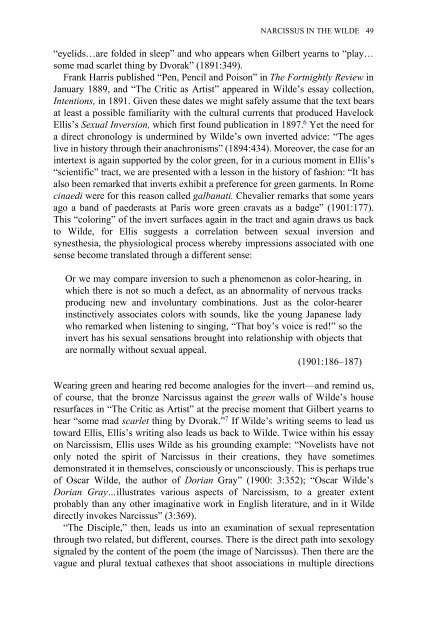Edited by Moe Meyer - Get a Free Blog
Edited by Moe Meyer - Get a Free Blog
Edited by Moe Meyer - Get a Free Blog
Create successful ePaper yourself
Turn your PDF publications into a flip-book with our unique Google optimized e-Paper software.
NARCISSUS IN THE WILDE 49<br />
“eyelids…are folded in sleep” and who appears when Gilbert yearns to “play…<br />
some mad scarlet thing <strong>by</strong> Dvorak” (1891:349).<br />
Frank Harris published “Pen, Pencil and Poison” in The Fortnightly Review in<br />
January 1889, and “The Critic as Artist” appeared in Wilde’s essay collection,<br />
Intentions, in 1891. Given these dates we might safely assume that the text bears<br />
at least a possible familiarity with the cultural currents that produced Havelock<br />
Ellis’s Sexual Inversion, which first found publication in 1897. 6 Yet the need for<br />
a direct chronology is undermined <strong>by</strong> Wilde’s own inverted advice: “The ages<br />
live in history through their anachronisms” (1894:434). Moreover, the case for an<br />
intertext is again supported <strong>by</strong> the color green, for in a curious moment in Ellis’s<br />
“scientific” tract, we are presented with a lesson in the history of fashion: “It has<br />
also been remarked that inverts exhibit a preference for green garments. In Rome<br />
cinaedi were for this reason called galbanati. Chevalier remarks that some years<br />
ago a band of paederasts at Paris wore green cravats as a badge” (1901:177).<br />
This “coloring” of the invert surfaces again in the tract and again draws us back<br />
to Wilde, for Ellis suggests a correlation between sexual inversion and<br />
synesthesia, the physiological process where<strong>by</strong> impressions associated with one<br />
sense become translated through a different sense:<br />
Or we may compare inversion to such a phenomenon as color-hearing, in<br />
which there is not so much a defect, as an abnormality of nervous tracks<br />
producing new and involuntary combinations. Just as the color-hearer<br />
instinctively associates colors with sounds, like the young Japanese lady<br />
who remarked when listening to singing, “That boy’s voice is red!” so the<br />
invert has his sexual sensations brought into relationship with objects that<br />
are normally without sexual appeal.<br />
(1901:186–187)<br />
Wearing green and hearing red become analogies for the invert—and remind us,<br />
of course, that the bronze Narcissus against the green walls of Wilde’s house<br />
resurfaces in “The Critic as Artist” at the precise moment that Gilbert yearns to<br />
hear “some mad scarlet thing <strong>by</strong> Dvorak.” 7 If Wilde’s writing seems to lead us<br />
toward Ellis, Ellis’s writing also leads us back to Wilde. Twice within his essay<br />
on Narcissism, Ellis uses Wilde as his grounding example: “Novelists have not<br />
only noted the spirit of Narcissus in their creations, they have sometimes<br />
demonstrated it in themselves, consciously or unconsciously. This is perhaps true<br />
of Oscar Wilde, the author of Dorian Gray” (1900: 3:352); “Oscar Wilde’s<br />
Dorian Gray…illustrates various aspects of Narcissism, to a greater extent<br />
probably than any other imaginative work in English literature, and in it Wilde<br />
directly invokes Narcissus” (3:369).<br />
“The Disciple,” then, leads us into an examination of sexual representation<br />
through two related, but different, courses. There is the direct path into sexology<br />
signaled <strong>by</strong> the content of the poem (the image of Narcissus). Then there are the<br />
vague and plural textual cathexes that shoot associations in multiple directions


